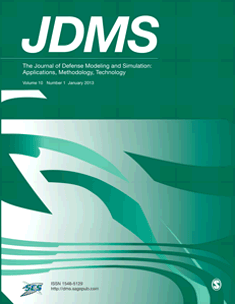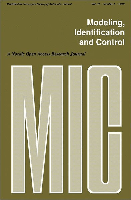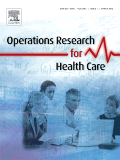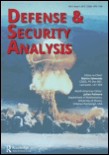
Journal of Defense Modeling and Simulation-Applications Methodology Technology-JDMS
Scope & Guideline
Innovating Defense Solutions through Comprehensive Simulation
Introduction
Aims and Scopes
- Modeling and Simulation Techniques:
The journal emphasizes various modeling approaches including agent-based, system dynamics, and discrete event simulation to analyze military operations and strategies. - Cybersecurity and Artificial Intelligence:
Research on the integration of AI and machine learning in defense applications, particularly in enhancing cybersecurity measures and operational efficiency. - Operational Analysis and Decision Support:
Focus on quantitative methodologies that support military decision-making processes, including wargaming, operational readiness assessments, and resource allocation. - Human Factors and Training:
Exploration of cognitive models, training methodologies, and human-machine interactions to improve military effectiveness and readiness. - Emerging Technologies in Defense:
Investigation of new technologies such as IoT, robotics, and advanced sensor systems that impact military operations and logistics. - Environmental and Structural Modeling:
Assessment of environmental impacts on military operations, including modeling of ballistic effects, terrain interactions, and material performance.
Trending and Emerging
- Adversarial Machine Learning:
The increasing focus on adversarial attacks and defenses in machine learning models highlights the importance of robust AI systems in command and control operations. - Integration of IoT in Defense Operations:
Research on IoT-enabled systems for enhancing situational awareness and operational efficiency is gaining traction, indicating a shift towards more interconnected military capabilities. - Enhanced Cyber Defense Mechanisms:
There is a growing emphasis on advanced cybersecurity frameworks and methodologies that address the complexities of modern cyber threats faced by military systems. - Data-Driven Decision Making:
The trend towards using big data analytics and machine learning for operational decision-making processes is becoming more pronounced, reflecting a shift towards data-centric military strategies. - Human-Machine Teaming:
Research focusing on the interaction between human operators and automated systems is emerging, emphasizing the need for effective collaboration in high-stakes military environments. - Resilience and Adaptability in Military Planning:
Studies that explore adaptive strategies and resilience in military logistics and planning processes indicate a growing recognition of the need to respond dynamically to unpredictable operational environments.
Declining or Waning
- Traditional Wargaming Techniques:
While wargaming remains important, traditional methods that do not incorporate advanced simulation technologies or AI have seen a decline as researchers gravitate towards more innovative and integrated approaches. - Basic Cybersecurity Concepts:
Research focusing solely on foundational cybersecurity principles without application to advanced technologies or scenarios has diminished as the field evolves towards more complex threat environments. - Conventional Military Strategy Analysis:
Studies that analyze military strategies using conventional frameworks without incorporating modern complexities like cyber warfare or hybrid threats are becoming less prevalent. - Static Simulation Models:
There is a noticeable decline in the use of static models that do not account for dynamic changes in the operational environment, as researchers seek more adaptable and responsive modeling techniques. - Single-Domain Focus Studies:
Research that focuses exclusively on one domain (land, air, or sea) without considering joint or multi-domain operations is waning as the complexity of modern warfare demands more integrated approaches.
Similar Journals

Journal of Simulation
Charting New Paths in Modeling and Engineering ExcellenceJournal of Simulation, published by Taylor & Francis Ltd, stands as a premier academic platform, addressing the intricate intersections of Industrial and Manufacturing Engineering, Management Science and Operations Research, Modeling and Simulation, and Software. With an ISSN of 1747-7778 and an E-ISSN of 1747-7786, this journal has established itself within the academic community, reinforced by its consistent ranking in the Q2 category across multiple fields as of 2023. The journal's coverage spans from 2008 to 2024, promoting innovative research and comprehensive reviews that influence industry practices and academic knowledge alike. Researchers, students, and professionals benefit from practical insights drawn from high-quality, peer-reviewed articles. Although the journal is not open access, its robust impact in the relevant fields, including a Scopus ranking placing it in the top 20% percentile in numerous categories, highlights its importance as a resource for advancing knowledge and fostering collaboration within the global simulation and modeling community.

Modelling
Unlocking Insights Across Scientific Disciplines.Modelling is a distinguished open access journal published by MDPI since 2020, dedicated to advancing the field of computational modeling across various scientific disciplines including Computer Science, Engineering, and Mathematics. With its base in Switzerland, the journal aims to foster a collaborative environment for researchers and practitioners while providing a platform for high-quality research on modeling and simulation techniques. As of 2023, it has garnered respectable rankings, achieving Q3 in Computer Science and Mathematics, and Q2 in Engineering, with notable Scopus values indicating an increasing impact within the academic community. Modelling not only publishes innovative research findings but also encourages the dissemination and discussion of emerging methodologies, making it a vital resource for scholars seeking to contribute to and expand the frontiers of knowledge in their respective fields. As an open access journal, it promotes unrestricted access to research outputs, ensuring greater visibility and impact for researchers and students alike.

SPE DRILLING & COMPLETION
Connecting researchers and professionals in petroleum engineering.SPE DRILLING & COMPLETION, published by the Society of Petroleum Engineers, is a distinguished journal that serves as a vital resource within the fields of energy engineering and mechanical engineering. With an ISSN of 1064-6671 and an E-ISSN of 1930-0204, this journal has been pivotal in disseminating crucial research and innovations since its inception in 1993. The journal holds an impressive impact factor that has positioned it in the Q2 quartile in both Energy Engineering and Power Technology and Mechanical Engineering, reflecting its significance in contemporary research. As evidenced by its Scopus rankings, it occupies notable percentiles within these fields, ranking #226 out of 672 in Mechanical Engineering and #104 out of 272 in Energy Engineering. While the journal currently offers traditional access options, it remains committed to advancing knowledge and fostering discussions surrounding drilling and completion techniques, making it a must-read for researchers, industry professionals, and students striving for excellence in petroleum engineering practices.

SIMULATION-TRANSACTIONS OF THE SOCIETY FOR MODELING AND SIMULATION INTERNATIONAL
Unleashing the Power of Simulation for Real-World ImpactSIMULATION-TRANSACTIONS OF THE SOCIETY FOR MODELING AND SIMULATION INTERNATIONAL, published by SAGE Publications Ltd, is a pivotal journal in the field of computer graphics, computer-aided design, mathematics, and modeling and simulation. With an ISSN of 0037-5497 and an E-ISSN of 1741-3133, the journal has established itself as a valuable resource since its inception in 1963, boasting a diverse archive leading up to 2024. Ranked in the Q2 category for both Computer Graphics and Mathematics, as well as Q3 for Modeling and Simulation and Software, it reflects a balanced distribution of quality research across multiple disciplines. The journal promotes accessibility through various open access options, ensuring wide dissemination of innovative findings. Researchers, professionals, and students alike will find insightful peer-reviewed articles that delve into advanced simulation methodologies and their applications in real-world scenarios, reinforcing its significant impact on the evolution of the simulation and modeling landscape.

RUSI Journal
Fostering critical analyses of geopolitical dynamics.RUSI Journal, published by Routledge Journals, Taylor & Francis Ltd, is a prestigious platform dedicated to advancing scholarship in the fields of Political Science and International Relations. With an ISSN of 0307-1847 and an E-ISSN of 1744-0378, this journal significantly contributes to the academic discourse, featuring original research, critical analyses, and essays that address contemporary security issues, strategic studies, and defense policy. Based in the United Kingdom, and operating since 1972, the journal has established a formidable reputation — achieving a Q3 ranking within its category in 2023, and positioning itself at the 57th percentile amongst over 700 peers in Scopus. Although it does not offer open access, the journal remains a vital resource for researchers, professionals, and students seeking to deepen their understanding of geopolitical dynamics and security challenges globally. With a commitment to rigorous scholarship and impactful insights, RUSI Journal continues to shape debates and influence policy within the international arena.

SIMULATION MODELLING PRACTICE AND THEORY
Unlocking the Potential of Simulation for Real-World Solutions.SIMULATION MODELLING PRACTICE AND THEORY is a leading academic journal published by Elsevier that focuses on the dynamic and evolving fields of simulation modeling and its applications across various disciplines. Established in 2002, this journal has rapidly gained recognition within the academic community, achieving a prestigious Q1 ranking in both Hardware and Architecture, as well as Modeling and Simulation for 2023. With an impressive impact factor that reflects its significance, it offers essential insights and findings pertinent to researchers, professionals, and students alike. The journal's scope encompasses a wide array of topics, encouraging interdisciplinary collaboration and innovation. Open access options further enhance visibility and accessibility of published research, contributing to the dissemination of knowledge in this critical field. Operating from its base in Amsterdam, Netherlands, SIMULATION MODELLING PRACTICE AND THEORY continues to provide a vital platform for advancements in simulation methodologies and applications, fostering an environment where theoretical principles and practical implementation converge.

MODELING IDENTIFICATION AND CONTROL
Exploring the Frontiers of Computer Science ApplicationsMODELING IDENTIFICATION AND CONTROL is a prominent academic journal dedicated to the fields of Computer Science Applications, Control and Systems Engineering, Modeling and Simulation, and Software. Published by MIC in Norway, this open access journal has been providing valuable insights and innovative research since 1980, promoting the free dissemination of knowledge. With a reputation reflected in its 2023 quartile rankings—Q3 in Computer Science Applications, Q2 in Control and Systems Engineering, and Modeling and Simulation, as well as Q3 in Software—this journal plays a vital role in advancing theoretical and practical solutions within its disciplines. Researchers and professionals benefit from its rigorous peer-review process and impactful publications, fostering collaboration and the exploration of emerging technologies across various applications. The journal's continual commitment to excellence is exemplified by its active presence in Scopus, where it maintains respectable rankings in relevant engineering and computer science subcategories, supporting its goal to be a pivotal resource for scholarly communication and practical advancements.

Operations Research for Health Care
Advancing health care systems through rigorous research.Operations Research for Health Care is a prominent journal dedicated to the intersection of operations research and health care optimization, published by Elsevier in the United Kingdom. With an ISSN of 2211-6923, this journal serves as a vital resource for researchers and practitioners seeking to apply quantitative and qualitative methodologies to improve health care systems and patient outcomes. Spanning from 2012 and ongoing through 2024, the journal is recognized for its impactful contributions, currently holding a Q2 ranking in multiple categories, including Health Professions and Oral Surgery, and a Q3 ranking in Management Science and Medicine. Its Scopus rankings reflect a robust standing in the field, with notable percentiles indicating wide recognition among researchers. Although it is not an open-access journal, its rigorous peer-review process ensures that published papers are of the highest quality, making it an essential platform for disseminating innovative ideas and best practices in health care operations research.

International Journal of Manufacturing Research
Transforming Ideas into Manufacturing BreakthroughsThe International Journal of Manufacturing Research, published by InderScience Enterprises Ltd, serves as a pivotal platform for disseminating innovative research in the field of manufacturing and industrial engineering. With an ISSN of 1750-0591 and E-ISSN of 1750-0605, this journal commits to fostering advancements in areas including manufacturing technologies, control systems, and simulation methodologies. It has established itself within the academic community despite its Q4 category rankings in Computer Science Applications and Control and Systems Engineering for 2023, and it holds a notable position in Industrial and Manufacturing Engineering with a Q3 ranking. The journal reflects the dynamic nature of the manufacturing sector, providing a crucial forum for researchers, professionals, and students to contribute their findings and insights. Although it does not currently offer open access options, its comprehensive scope from 2006 to 2020 and 2022 to 2024 emphasizes its commitment to addressing contemporary challenges in manufacturing and technology. Engaging with this journal can enhance understanding and drive innovation among industry experts and scholars alike.

Defence and Security Analysis
Unraveling Complexities of Geopolitical Challenges.Defence and Security Analysis is an esteemed journal that focuses on the critical intersections of security studies, international relations, and geopolitical dynamics. Published by Routledge Journals, Taylor & Francis Ltd in the United Kingdom, this journal serves as a vital platform for scholars, practitioners, and students to disseminate innovative research and insights concerning contemporary defence and security issues. With an ISSN of 1475-1798 and an E-ISSN of 1475-1801, it has achieved a commendable standing, ranking in the Q2 category for Political Science and International Relations and Q3 for Geography, Planning and Development as of 2023. The journal covers a range of pertinent topics with a dedicated convergence of years from 2003 to 2024, making it an invaluable resource for anyone looking to engage deeply with this evolving field. Although it is not open access, its rich content is crucial for informing policy and academic discourse on global security challenges.